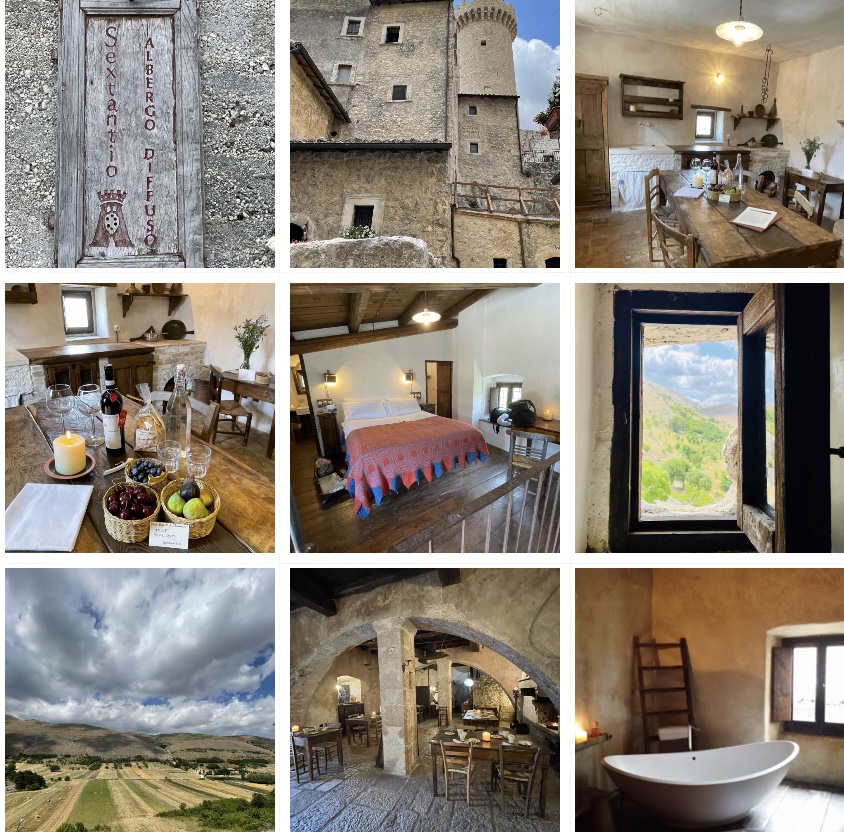

If you have been to Italy and visited all the main cities and resorts you might be looking for something out of the ordinary. That is exactly why we decided to visit Abruzzo, a region in central Italy, stretching from the Apennine Mountains to the Adriatic Sea. It is known for its mountain ranges, national parks, medieval hilltop villages, and areas rich in olive groves and vineyards. It is laid-back, slower-paced, and picturesque.
We stayed in a fortified medieval village called Santo Stefano di Sessanio. It is located 1200 meters above sea level, inside the Gran Sasso and Monti Della National Parks. The village is a classic example of an Italian medieval town with a large tower, perimeter walls, a small main square, and historic houses, that were once occupied by weavers, shepherds, and livestock. The town dates back several centuries but was later abandoned due to the poor economy and impoverished inhabitants. They left in search of work and the homes were literally saved from architectural changes. It was brought back to life as an Albergo Diffuso by hotelier Daniele Kihlgren.
The Sextantio Albergo Diffuso has accommodations that are dispersed among several stone houses of the ancient village. The hotel has tried to retain its original look and feel. They have incorporated traditional handicrafts and tried to preserve the integrity of the original structure. All modern technology is hidden, and the original stone and foundations and walls are brought back to their authentic features.
The decor is simple, and rustic, using locally handwoven linens and bedspreads. You actually feel like you are staying in an original ancient dwelling and that you are stepping back in time. But the bathrooms are designed by Phillipe Stark and yes there is electricity.
There are two hotel restaurants in town, Cantione is less formal, a wine bar/cafe, and an atmospheric restaurant called Locanda Sotti Gli Archi, that serves traditional Abruzzo cuisine, using local recipes and produce grown on nearby farms. Both are nothing to write home about but are adequate. A simple breakfast is served as part of the room rate.
The hotel offers cooking classes, weaving, soap making, and wine tasting. Outside you can hike, bike, horseback ride, and tour old towns and villages. It is an easier and simpler lifestyle. There are no taxis so if you didn’t rent a car you must hire a driver, which is not a bad idea on these curvy and unlit mountain roads.
This place isn’t for everyone, especially if you demand modern comforts. There are no TVs or telephones. No air conditioning, which is typical in all of Abruzzo. No turndown service or Kleenex or products. No gym or spa. Sparsely furnished rooms. The mattress feels like it is from the Middle Ages. There is not much storage space. The gas heater located in the closet smelled of gas fumes. It’s a walk to the lobby or the restaurants, and need to wear comfortable walking shoes because of the uneven pavement everywhere. Overall would be a difficult destination for guests seeking accessible accommodations.
However, the hotel and village are charming, with a friendly staff. The prices for meals and lodging are very reasonable. The village is beautifully situated in an authentic ancient village. It is a quiet, unhurried vacation.
The area is largely undiscovered by tourists. It is a unique and authentic cultural experience that gives you a peek into Abruzzo’s past and allows you to live like a local.
Happy travels (once again!),
Shanea